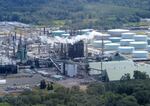Washington faced unwelcome news last week that the state’s average price for a gallon of gas is the highest in the country.
Some policy and energy experts have tied the increase to the state's new climate change policies, while others point to supply chain issues as a key driver for rising prices across the region. It's sparking renewed debate about Washington's response to climate change and the future of energy costs.
Gas prices have been on the rise in Washington for months. According to AAA, Washington’s average price for a gallon of gas reached $4.96 as of Friday, with a handful of counties in Western Washington exceeding $5 per gallon. That’s higher than the average price in California, which is typically the costliest state for drivers to fuel up. A Seattle Times analysis of AAA data also shows average gas prices between Washington and Oregon growing further apart this year, after years of them being within a similar range.
Some critics say the state's new carbon emissions cap program is largely to blame.
Earlier this year, Washington began using a new program aiming to limit carbon emissions in the state. The "cap-and-invest" program essentially limits carbon emissions and requires companies to bid on emissions allowances, which will be reduced over time. The money raised from those auctions is earmarked for green energy investments.

The 400-mile Olympic Pipeline carries gasoline, diesel and jet fuel from refineries in northern Washington state, such as BP Cherry Point shown here, to a distribution hub in Portland, Oregon.
Tom Banse / NW News Network, 2016
The Department of Ecology, which runs the new program, says the state doesn't have enough information to determine how much it's influencing gas prices right now, partly because it's been operational for only a matter of months. Program manager Luke Martland says companies set prices based on several factors, not a single climate policy.
"Claims that cap-and-invest is driving up your gas prices – that's really simplistic," he said.
Martland says the state estimated that the program would have some impact, but the estimates vary. Gov. Jay Inslee assured the public last year that the impact would be minimal.
Claire Boyte-White, policy relations manager for the cap-and-invest program, says as a whole, Washington's new climate policies are supposed to create financial incentives for companies to develop and provide more green energy options.
“It’s designed to increase market competition in the transportation industry so that we do have alternatives to fossil fuel and single passenger transport,” Boyte-White said.
Part of that will naturally mean higher prices for gas consumers, said Scott Montgomery, an assistant lecturer and energy policy expert at the University of Washington.
"The focus at some point or another…will involve higher prices for fossil fuels as a whole, even while they are being slowly replaced," he said.
Montgomery says prices could cool off after the summer months, noting that oil companies likely want to keep prices affordable enough so that people are still willing to buy fuel for their vehicles.
Nevertheless, he and others say the new carbon cap program isn't the only factor behind the higher prices people are paying at the pump.
Montgomery and others point out that maintenance on a major local oil pipeline has tightened the region's supply, as demand grows with more people hitting the road for summer travel.
"It does show the vulnerability of the supply chain system," he said. "Washington state has only a few relatively small refineries, so if one of them goes offline or if a major pipeline has maintenance on it – or both of those things together – that's going to push prices up abnormally high."
These same factors are likely moving gas prices in Oregon, too. According to AAA, Oregon saw the country’s highest weekly jump in average gas prices last week. The average price in Oregon is the fourth highest in the country at $4.62, behind California and Hawaii. States along the West Coast are typically among the highest average gas prices in the country.